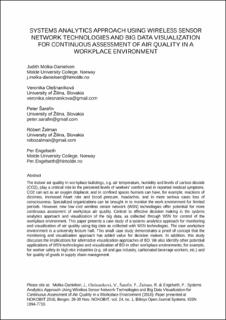| dc.description.abstract | The indoor air quality in workplace buildings, e.g. air temperature, humidity and levels of carbon dioxide (CO2), play a critical role in the perceived levels of workers' comfort and in reported medical symptoms. CO2 can act as an oxygen displacer, and in confined spaces humans can have, for example, reactions of dizziness, increased heart rate and blood pressure, headaches, and in more serious cases loss of consciousness. Specialized organizations can be brought in to monitor the work environment for limited periods. However, new low cost wireless sensor network (WSN) technologies offer potential for more continuous assessment of workplace air quality. Central to effective decision making is the systems analytics approach and visualization of the big data, as collected through WSN for control of the workplace environment. This paper presents a case study of a systems analytics approach for monitoring and visualization of air quality using big data as collected with WSN technologies. The case workplace environment is a university lecture hall. This small case study demonstrates a proof of concept that the monitoring and visualization approach has added value for decision makers. In addition, this study discusses the implications for alternative visualization approaches of BD. We also identify other potential applications of WSN technologies and visualization of BD in other workplace environments; for example, for worker safety in high risk industries (e.g. oil and gas industry, carbonated beverage workers, etc.) and for quality of goods in supply chain management. | en_US |
